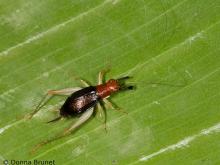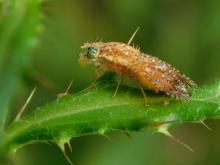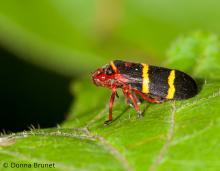Land Invertebrates
Media

Species Types
Scientific Name
Panorpa spp.
Description
Male scorpionflies will make you look twice, because the abdomen is tipped with what looks like a scorpion stinger! These nifty insects cannot sting, however.
Media

Species Types
Scientific Name
About 84 species in North America.
Description
Many blow flies are so shiny and colorful they’re called greenbottles and bluebottles. But pretty as they are, it’s hard not to be repulsed by their larval diets.
Media

Species Types
Scientific Name
About 30 species in North America north of Mexico
Description
Stilt-legged flies are a family of true flies. They are harmless, but most species resemble ichneumon wasps or ants. The middle and back pairs of legs are exceptionally long and thin, while the front pair of legs are much shorter.
Media

Species Types
Scientific Name
Phyllopalpus pulchellus
Description
The handsome trig lives in vegetation about four feet off the ground near water. This beetle-like cricket may be a mimic of bombardier beetles, which spew foul chemicals for defense.
Media

Species Types
Scientific Name
Gelastocoris oculatus
Description
With their bulging eyes and squat shape, big-eyed toad bugs really do look a lot like tiny toads. Their genus name means "laughable bug" or "ridiculous bug."
Media

Species Types
Scientific Name
About 300 species in North America north of Mexico
Description
Tephretid fruit flies, in the family Tephritidae, are often called peacock flies for the intricately patterned, often brightly colored wings of many species.
Media

Species Types
Scientific Name
8 tribes, with about 23 genera, in North America north of Mexico
Description
Millipedes in family Xystodesmidae often have bright colors that serve as a warning to potential predators that they may secrete foul or toxic substances.
Media

Species Types
Scientific Name
Poecilopompilus algidus and P. interruptus
Description
Poecilopompilus spider wasps provision their nests with orbweaver spiders. They dig nest burrows into the ground and therefore prefer sandy or other workable substrates.
Media

Species Types
Scientific Name
Entypus aratus, E. unifasciatus, E. fulvicornis, and others
Description
Spider wasps in genus Entypus are bluish black and usually have some amount of amber color on their dark, smoky wings. Some species have bright yellow antennae.
Media

Species Types
Scientific Name
Prosapia bicincta
Description
The two-lined spittlebug is a common member of the froghopper family. The two lines may be red, orange, or yellow. Some individuals are all black, except for the red eyes.
See Also



Media

Species Types
Scientific Name
Cisseps fulvicollis
Description
The yellow-collared scape moth is more often “orange-collared.” And whether you think it looks more like a firefly or a wasp, it’s still a moth!
Media

Species Types
Scientific Name
Nearly 150 species in North America north of Mexico
Description
Slim, delicate plume moths are instantly recognizable by their T-shaped silhouette, long legs, and muted shades of tan and brown. It can be hard to separate the various species.
Media

Species Types
Scientific Name
Pyrrharctia isabella
Description
Not many people know the adult Isabella tiger moth when they see one, but we’re all acquainted with its caterpillar, the woolly worm, or woolly bear.
About Land Invertebrates in Missouri
Invertebrates are animals without backbones, including earthworms, slugs, snails, and arthropods. Arthropods—invertebrates with “jointed legs” — are a group of invertebrates that includes crayfish, shrimp, millipedes, centipedes, mites, spiders, and insects. There may be as many as 10 million species of insects alive on earth today, and they probably constitute more than 90 percent all animal species.





















